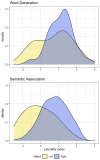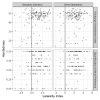Investigating the effects of handedness on the consistency of lateralization for speech production and semantic processing tasks using functional transcranial Doppler sonography
- PMID: 33715589
- PMCID: PMC7611699
- DOI: 10.1080/1357650X.2021.1898416
Investigating the effects of handedness on the consistency of lateralization for speech production and semantic processing tasks using functional transcranial Doppler sonography
Abstract
The left hemisphere is dominant for language in most people, but lateralization strength varies between different tasks and individuals. A large body of literature has shown that handedness is associated with lateralization: left handers have weaker language lateralization on average, and a greater incidence of atypical (right hemisphere) lateralization; but typically, these studies have relied on a single measure of language lateralization. Here we consider the relationships between lateralization for two different language tasks. We investigated the influence of handedness on lateralization using functional transcranial Doppler sonography (fTCD), using an existing dataset (N = 151 adults, 21 left handed). We compared a speech production task (word generation) and a semantic association task. We demonstrated stronger left-lateralization for word generation than semantic association; and a moderate correlation between laterality indices for the two tasks (r = 0.59). Laterality indices were stronger for right than left handers, and left handers were more likely than right handers to have atypical (right hemisphere) lateralization or inconsistent lateralization between the two tasks. These results add to our knowledge of individual differences in lateralization and support the view that language lateralization is multifactorial rather than unitary.
Keywords: Laterality index; functional transcranial Doppler sonography (fTCD); handedness; hemispheric dominance; language.
Conflict of interest statement
Figures





Similar articles
-
Cerebral Lateralization During Handwritten and Typed Word Generation: A Functional Transcranial Doppler Ultrasound Study in Left-Handers and Right-Handers.Eur J Neurosci. 2025 Feb;61(4):e70013. doi: 10.1111/ejn.70013. Eur J Neurosci. 2025. PMID: 39973471 Free PMC article.
-
Investigating language lateralization during phonological and semantic fluency tasks using functional transcranial Doppler sonography.Laterality. 2015;20(1):49-68. doi: 10.1080/1357650X.2014.914950. Epub 2014 May 29. Laterality. 2015. PMID: 24875468 Free PMC article.
-
An updated investigation of the multidimensional structure of language lateralization in left- and right-handed adults: a test-retest functional transcranial Doppler sonography study with six language tasks.R Soc Open Sci. 2021 Feb 3;8(2):200696. doi: 10.1098/rsos.200696. R Soc Open Sci. 2021. PMID: 33972838 Free PMC article.
-
Gaussian mixture modeling of hemispheric lateralization for language in a large sample of healthy individuals balanced for handedness.PLoS One. 2014 Jun 30;9(6):e101165. doi: 10.1371/journal.pone.0101165. eCollection 2014. PLoS One. 2014. PMID: 24977417 Free PMC article.
-
Cerebral asymmetry and language development: cause, correlate, or consequence?Science. 2013 Jun 14;340(6138):1230531. doi: 10.1126/science.1230531. Science. 2013. PMID: 23766329 Free PMC article. Review.
Cited by
-
Cerebral Lateralization During Handwritten and Typed Word Generation: A Functional Transcranial Doppler Ultrasound Study in Left-Handers and Right-Handers.Eur J Neurosci. 2025 Feb;61(4):e70013. doi: 10.1111/ejn.70013. Eur J Neurosci. 2025. PMID: 39973471 Free PMC article.
-
Microstructural asymmetries of the planum temporale predict functional lateralization of auditory-language processing.Elife. 2024 Dec 16;13:RP95547. doi: 10.7554/eLife.95547. Elife. 2024. PMID: 39679659 Free PMC article.
-
Lateralized Changes in Language Associated Auditory and Somatosensory Cortices in Autism.Front Syst Neurosci. 2022 Mar 1;16:787448. doi: 10.3389/fnsys.2022.787448. eCollection 2022. Front Syst Neurosci. 2022. PMID: 35300070 Free PMC article. Review.
-
Language Dominance in Left-Handers: Unveiling Left Hemisphere Global Dominance With Specific Right Hemisphere Regional Dominance.Cureus. 2024 Nov 28;16(11):e74691. doi: 10.7759/cureus.74691. eCollection 2024 Nov. Cureus. 2024. PMID: 39735149 Free PMC article.
-
Generalized models for quantifying laterality using functional transcranial Doppler ultrasound.Hum Brain Mapp. 2023 Jan;44(1):35-48. doi: 10.1002/hbm.26138. Epub 2022 Nov 14. Hum Brain Mapp. 2023. PMID: 36377321 Free PMC article.
References
MeSH terms
Grants and funding
LinkOut - more resources
Full Text Sources
Other Literature Sources
